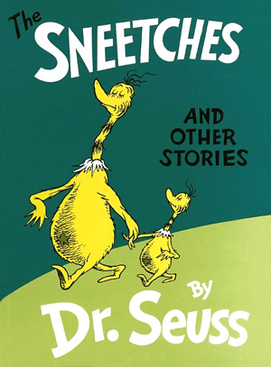The Sneetches and Other Stories facts for kids

Front cover with Seuss illustration
|
|
| Author | Dr. Seuss |
|---|---|
| Genre | Children's picture book, short stories in rhyme |
| Publisher | Redbook (magazines) Random House (book) |
|
Publication date
|
July 1953 (Redbook) (The Sneetches) March 1954 (Redbook) (The Zax) August 28, 1961 (renewed 1989) |
| Media type | Print (hardcover) |
| Pages | 65 pp. |
| OCLC | 470409 |
| LC Class | PZ8.3.S477 Sn 1961 |
| Preceded by | Green Eggs and Ham |
| Followed by | Dr. Seuss's Sleep Book |
The Sneetches and Other Stories is a collection of fun tales by the famous American children's author, Dr. Seuss. It was first published in 1961. This book shares four different stories that teach important lessons. These lessons are about being kind to everyone, celebrating differences, and learning to get along.
The book includes "The Sneetches," "The Zax," "Too Many Daves," and "What Was I Scared Of?". Many people love this book. It was even listed as one of the "Teachers' Top 100 Books for Children" in 2007. In 2012, it was ranked among the top 100 picture books by School Library Journal.
Two of the stories, "The Sneetches" and "The Zax," were later made into a TV cartoon. This happened in 1973 as part of Dr. Seuss on the Loose.
Contents
The Stories Inside
The Sneetches: Learning About Acceptance
This first story is about yellow, bird-like creatures called Sneetches. Some Sneetches have a green star on their bellies, and some do not. At the start, the star-bellied Sneetches think they are better. They are mean to the Sneetches without stars.
Then, a clever salesman named Sylvester McMonkey McBean arrives. He calls himself the "Fix-It-Up Chappie." He offers to give stars to the plain-bellied Sneetches for a small fee. Everyone wants a star!
But this makes the original star-bellied Sneetches upset. They do not want to be like everyone else. So, McBean offers a new machine to take stars off. The Sneetches go back and forth, adding and removing stars. They spend all their money trying to be special.
Soon, no one can tell who had a star first. They are all mixed up! McBean leaves with all their money. Even though he thought Sneetches could not learn, they do. They realize that having a star or not does not make anyone better. They learn to be friends and accept each other. Dr. Seuss wrote "The Sneetches" to show how silly it is to judge people based on small differences. It teaches us to be kind to everyone, no matter how they look.
The Zax: A Lesson in Compromise
In "The Zax," two stubborn creatures meet on a wide prairie. One is a North-going Zax, and the other is a South-going Zax. They bump into each other and both demand the other move. Neither will budge, saying it is against their nature.
They stand there, arms crossed, refusing to move even a little bit. They are so stubborn that time passes, and a big highway is built right around them! The story ends with the Zax still standing there, stuck in their tracks. This story teaches us how important it is to compromise and be flexible. Sometimes, it is better to give a little to get along.
Too Many Daves: A Funny Name Game
"Too Many Daves" is a very short and funny story. It is about a mom, Mrs. McCave, who named all 23 of her sons Dave. This causes some small problems in the family.
The story then lists many funny and unusual names she wished she had chosen instead. Imagine names like "Bodkin Van Horn," "Hoos Foos," "Snimm," or "Zanzibar Buck-Buck McFate"! The story ends by saying she never did change their names, and now it is too late.
What Was I Scared Of?: Facing Your Fears
"What Was I Scared Of?" tells the tale of a character who keeps seeing an empty pair of pale-green pants. These pants appear in dark and spooky places. The character, who is also the narrator, is very afraid of them at first. The pants can even stand up by themselves!
But then, when the narrator screams for help, the pants start to cry too. The narrator realizes something important: the pants are just as scared as he is! After this, the empty pants and the narrator become good friends. This story teaches us that sometimes the things we fear are not so scary after all.
Spreading Tolerance with NATO
In 1998, a group called NATO helped share the message of "The Sneetches." NATO is an alliance of many countries that work together for peace and safety. They translated the book into Serbo-Croatian. They planned to give out many copies to children in Bosnia and Herzegovina. This was part of a plan to help teach kids about tolerance and getting along after a difficult time in their country. About 50,000 copies were distributed to help spread this important message.

